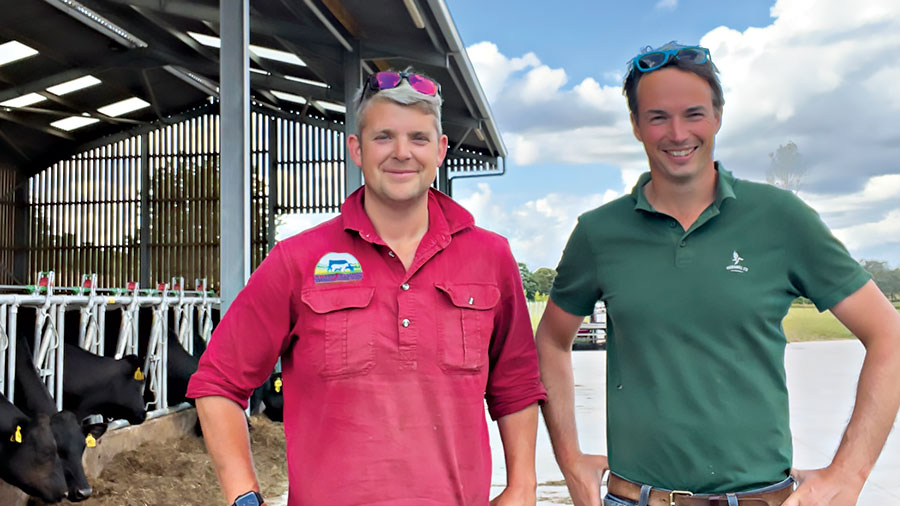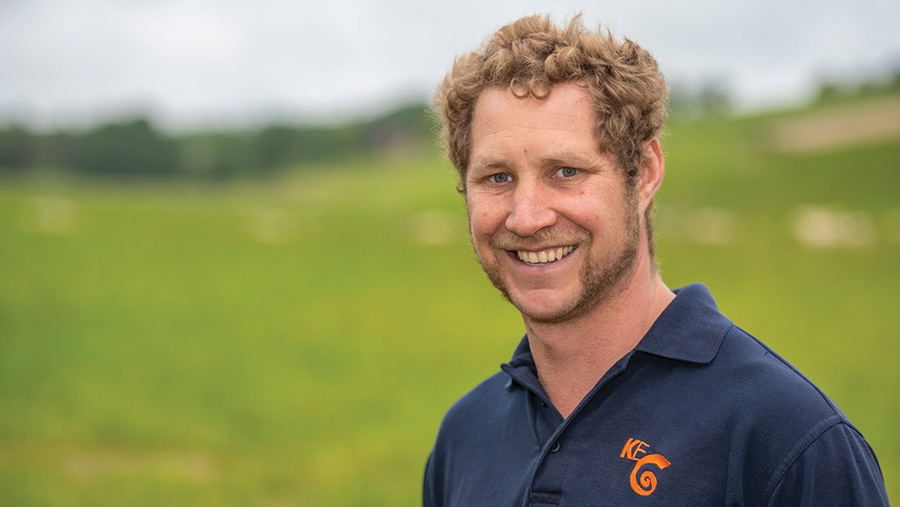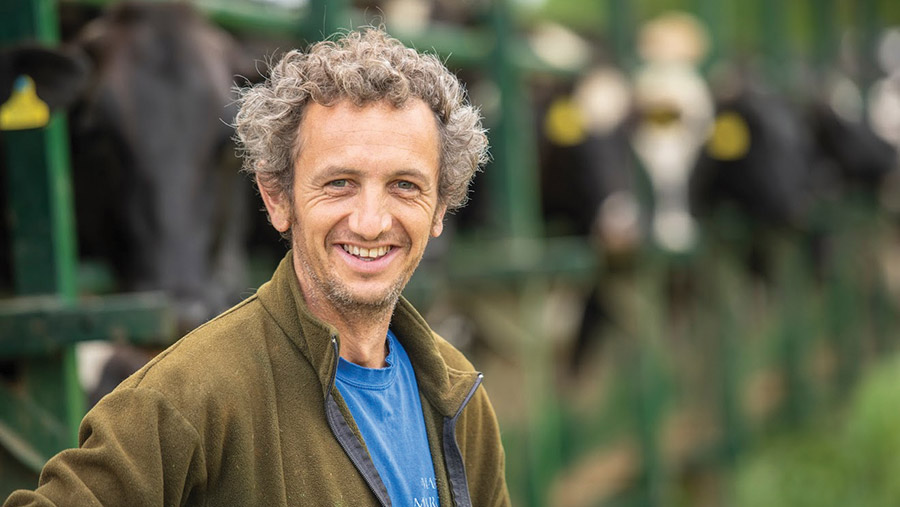Share farming offers alternative structure with benefits
 Sam Clarke (left) and James Price © James Price
Sam Clarke (left) and James Price © James Price The use of share farming agreements could rise as tighter gross margins and further cuts to direct subsidies in England make alternative arrangements such as contract farming less relevant.
Share farming agreements operate where two parties jointly farm the same land, typically involving the owner or tenant of farmland entering a contract with a share farmer.
Gary Markham, director at rural tax adviser and accountant Land Family Business, describes it as a true joint venture.
See also: CFAs need new approach in light of BPS phase out
He expects many alternative agreements to convert to the share farming model from this autumn onwards for several reasons, including financial sustainability, flexibility and to protect the inheritance tax (IHT) position of farm owners.
The most common form of joint venture historically has been a contract farming agreement (CFA) with the Basic Payment Scheme (BPS) income included in the operation.
However, with cuts to the BPS since 2020, these agreements have come under pressure because there is less return for the contractor, says Gary.
Share farming principles
- Joint venture between (usually) two businesses
- Gross margin shared, reflecting resources and contributions of each party
- Shared costs and profits
- Requires good communication and clear objectives
- Clear written agreement needed including exit strategy
“In arable, the good returns from the 2021 and 2022 harvests have been a sticking plaster; they have delayed that financial pressure, but prices in 2023 will be much lower and inputs higher and it will be crunch time.
“There will be a rush from the autumn through to the spring to restructure joint ventures – share farming is the absolute answer.”
Shared gross margin
This is because the gross margin is shared, in contrast to CFAs, where the landowner or farmer and the contractor each receives a fixed amount in advance of a share of the surplus from the farming operation.
For the contractor, this is a basic contracting fee that should at least cover their costs, while the landowner receives a fixed charge for the provision of land, buildings and a share farming bank account to fund the operation.
With lower 2023 harvest returns and BPS dropping, the sum due to the contractor as their share of the surplus will be substantially reduced, says Gary.
There may be good IHT reasons for shifting from a CFA to share farming, as in some cases HMRC might see the farmer as not being sufficiently involved in the management of the land, running the risk that they could lose agricultural property relief (APR).
“Share farming is a robust model for IHT,” says Gary, who has already adapted agreements into share farming models by changing the remuneration.
Share farming advantages
- Flexibility
- Both parties separate for income and other tax purposes, retaining working farmer/trading status
- Can offer a start to a new entrant on a small scale with opportunity to build shares
- Fits with changing farming landscape
- Good model for bringing livestock into arable rotations
Instead of the usual CFA method, he suggests splitting the gross margin to reflect the value of each party’s respective inputs to the agreement.
Share farming suits all enterprises
While share farming is often associated with dairying, having originated in New Zealand where share milking is common, it is suited to all enterprises.
In recent years, the model has gained traction in arable situations, with livestock farmers introducing sheep and cattle onto arable land to increase soil organic matter.
This presents a good opportunity for new entrants because of the relatively low capital start-up costs of a sheep enterprise, he adds.
The model can also be a good fit for farm diversifications, too. Gary’s livery business operates in his buildings within a share farming agreement.
“Renting out farm buildings is not good for IHT; share farming is better as it demonstrates that the farmer is involved in farming or activities for the purposes of APR or business property relief,” Gary says.
The Tenant Farmers Association (TFA) advises on joint ventures as well as tenancies. It sees share farming as a niche solution that suits in limited circumstances.
Chief executive George Dunn says there has been no increase in share farming inquiries and puts this down largely to the landowning community being risk averse.
“For two individuals to share risk, you have to focus on specific goals and not everyone can cope with that,” he says.
Case study: James Price and Sam Clarke

Sam Clarke (left) and James Price © James Price
When arable farmer James Price was offered an additional 650ha of land to rent, it presented a business opportunity not only for him but for a sheep farmer, too.
James took on the new land in Oxfordshire and formed a separate joint venture, Mustard Sheep, with shepherd and agricultural consultant Sam Clarke, to graze 1,200 sheep on cover crops.
The business not only generates a secondary income from the land, but helps manage blackgrass and introduces organic matter into the arable soils.
The pair had been close friends for several years and already had a business relationship – Sam’s sheep grazed mustard cover crops that James had introduced to improve his arable soils.
Share farming was the logical next step when James had the chance to expand his arable operation to about 1,500ha.
“It was a big jump in acreage and the land had some issues with weeds, but it was an opportunity I couldn’t turn down,” he says.
Joint venture
He decided to plant 162ha of herbal leys to help manage those issues and to graze it with sheep, offering Sam that opportunity.
“Sam couldn’t justify buying additional sheep to graze that acreage without a more permanent arrangement so I suggested we did it together, as a joint venture,” says James.
James provided the land, Sam the handling and other equipment, which he already owned, and each put in 600 North Country Mule ewes.
Mustard Sheep has its own bank account, which is used for receiving the income and paying the variable costs associated with running the joint venture.
This includes income from sales of lambs and cull ewes and expenditure on seed. There was a big cost in year one when the herbal leys were planted.
Labour is also paid from the account – the business employs 1.5 labour units and Sam, who also works as an agricultural consultant, is paid a fee for managing the sheep enterprise; James has no involvement in the day-to-day running of the business. Insurance cover has been added to James’ existing policy.
“Because we were a new business, the quotes for having a separate policy were very high so I was able to tack it onto my policy,” says James.
This additional premium will be charged back at cost to Mustard Sheep.
Equal profit shares
Profits from the joint venture are shared equally. Both parties recognise that they benefit from the arrangement, which was established in September 2022.
“Land is one thing you can’t farm without so it has given me the opportunity to push my business on and James benefits because I was already well kitted out with equipment, fencing and labour, what you might call ‘oven ready’,” says Sam.
The pair talk daily on the phone and have formal quarterly meetings to assess the business and to plan ahead.
Although they had worked together previously through the grazing arrangements, forming the joint venture has given both a mutual appreciation of the needs of each other’s enterprises.
“If I need the sheep off by 14 February to plant spring barley, Sam understands that. We have a common interest so we plan where the sheep will graze,” says James.
Monitoring cashflows
For farmers considering new agreements, James recommends closely monitoring cashflows.
“It is important to understand where the money is coming from,” he says, adding that successful share farming agreements rely on several elements.
“The key to it is to get on very well and that you can have a good working relationship.
“Having different skill sets is important, too. Sam has the expertise with the sheep but also has agronomy experience so he understands the needs of my arable system.”
Case study: Tim May and Oliver Chedgey
In a good trading year, Tim May and Oliver Chedgey share the glory. In a poor year, the financial hit on their dairy farming business is also split two ways.
The pair have been share farming since 2017 after Tim decided to reintroduce a dairy herd to Kingsclere Estates, his family’s 1,012ha farm in north Hampshire, to build soil health and reduce the weed burden in the arable enterprise.
“I recognised the farm’s biggest strength was grass and dairy and wanted to get livestock back onto the farm to get grass back into the rotation,” he says.

Tim May © Kingsclere Estates
A farm business tenancy model was not the right fit because Tim didn’t want the dairy fixed on a specific acreage. He wanted the benefit from the cows to be spread across the entire farm.
“We could have set the dairy up ourselves and employed a herdsman, but there was always the risk of that person leaving and we would have to start the process all over again,” he says.
Tim sought advice from Christopher D’Olley, a partner at land agent Carter Jonas, a keen advocate of share farming.
The opportunity was advertised in Farmers Weekly and, in 2017, Tim established a share farming business with Oliver, on a five-year rolling agreement.
The business now milks 420 New Zealand Friesian cross-breds in a 20-a-side mobile milking parlour.
Tim provides the land and home-grown feed and Oliver owns the machinery and puts in labour and his expertise and knowledge of dairying.
Running costs
The cows are owned equally. Interest and depreciation on new infrastructure or machinery contributed by either party is accounted for.
“No one gets paid directly for what they contribute, but that value gets attributed to their share of the running costs,” Tim explains. “When we apportion the sales it is accounted for then.”
Running costs such as contracting and veterinary fees are shared – their suppliers invoice them separately for 50% of the total cost of the service or goods.
The cost of insurance cover for the cows is shared, but Tim has his own public liability insurance for the estate and Oliver has cover for his own business.

Oliver Chedgey © Kingsclere Estates
Alongside the share farming agreement is a farming policy agreement that sets out who is responsible for what.
This covers issues such as ensuring that no metal fencing stakes from temporary fence lines are left lying around the farm as a hazard for other farm equipment.
It is a live document so new responsibilities can be integrated as they arise.
Tim says one of the appeals of share farming is that it doesn’t come with some of the legal obligations of a partnership.
“When you are setting up a new, young business, having that separation is important,” he believes. What it does do is bring two managerial minds together.
Sharing responsibility
“It is not a landowner-farmer relationship, it is two people working together and sharing the responsibility,” Tim adds.
For it to work, everyone involved needs to understand the concept of the share farming model, he says.
“Not everyone will understand share farming because it is not as mainstream as a partnership or tenancy,” he adds.
It is important the agreement has a clear exit strategy too, to allow the agreement to end amicably if needed.
